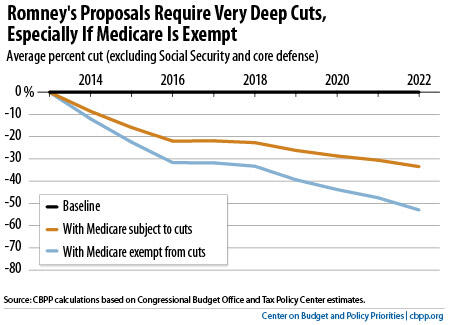BEYOND THE NUMBERS
Examining the Romney Budget Proposals
We’ve updated our analysis of Governor Romney’s budget proposals. Here’s the overview:
Governor Mitt Romney’s proposals to cap total federal spending at 20 percent of gross domestic product (GDP) and boost defense spending to 4 percent of GDP would require very large cuts in other programs, both entitlements and discretionary programs.
This update of an earlier analysis is based on updated economic and budget projections that the Congressional Budget Office (CBO) issued this summer and additional information that the Romney campaign has provided on his budget proposals. The resulting estimates of the required budget cuts are somewhat smaller than the ones we released on May 21, but they are still very deep.
For the most part, Governor Romney has not outlined cuts in specific programs. But if policymakers repealed health reform (the Affordable Care Act, or ACA) and exempted Social Security from cuts, as Romney has suggested, and cut Medicare, Medicaid, and all other entitlement and discretionary programs by the same percentage to meet Romney’s overall spending cap and defense spending target, then they would have to cut non-defense programs other than Social Security by 22 percent in 2016 and 34 percent in 2022. If they exempted Medicare from cuts for this period, the cuts in other programs would have to be even more dramatic — 32 percent in 2016 and 53 percent in 2022.
If they applied these cuts proportionately, the cuts in programs such as veterans’ disability compensation, Supplemental Security Income (SSI) for poor elderly and disabled individuals, the Supplemental Nutrition Assistance Program (SNAP, formerly food stamps), school lunches and other child nutrition programs, and unemployment compensation would cause the incomes of large numbers of households to fall below the poverty line. Many who already are poor would become poorer.
The cuts in nondefense discretionary programs — a spending category that covers a wide variety of public services such as elementary and secondary education, law enforcement, veterans’ health care, environmental protection, and biomedical research — would come on top of the substantial cuts in this part of the budget that are already in law, due to the discretionary funding caps in last year’s Budget Control Act (BCA). By 2022, the cuts under Governor Romney’s budget proposals would shrink nondefense discretionary spending — which, over the past 50 years, has averaged 3.9 percent of GDP and never fallen below 3.2 percent — to 1.8 percent of GDP if Medicare shares in the cuts, and to 1.3 percent of GDP if it does not.
These cuts would be noticeably deeper than those required under the austere House-passed budget plan authored by Budget Committee Chairman Paul Ryan (R-WI). (Romney’s nondefense cuts are deeper because his proposal increases core defense spending — the defense budget other than war costs and some relatively small items such as military family housing — to 4 percent of GDP, while the Ryan budget does not.) Over the coming decade, Romney would require cuts in programs other than core defense of $6.1 trillion, compared with $5.0 trillion in cuts under the House-passed budget plan.

Click here for the full report
